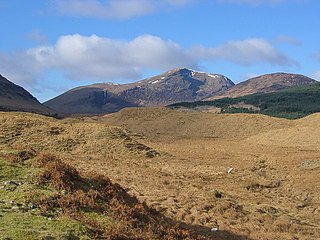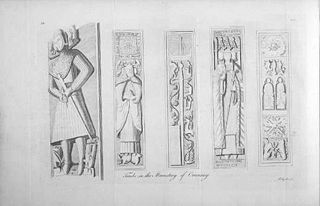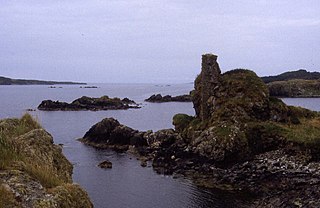
Rathlin Island is an island and civil parish off the coast of County Antrim in Northern Ireland. It is Northern Ireland's northernmost point. As of the 2021 Census there are 141 people living on the island.

Edward Bruce, Earl of Carrick, was a younger brother of Robert the Bruce, King of Scots. He supported his brother in the 1306–1314 struggle for the Scottish crown, then pursued his own claims in Ireland. Proclaimed High King of Ireland in 1315 and crowned in 1316, he was eventually defeated and killed by Anglo-Irish forces of the Lordship of Ireland at the Battle of Faughart in County Louth in 1318.
Somhairle Buíodh MacDonnell, known as Sorley Boy MacDonnell, whose last name was also given as MacDonald, was a Gaelic chief, the son of Alexander Carragh MacDonnell, 5th of Dunnyveg, of Dunyvaig Castle, lord of Islay and Cantire, and Catherine, daughter of the Lord of Ardnamurchan, both in Scotland. MacDonnell is best known for establishing the MacDonnell clan in Antrim, Ireland, and resisting the campaign of Shane O'Neill and the English crown to expel the clan from Ireland. Sorley Boy's connection to other Irish Roman Catholic lords was complicated, but also culturally and familiarly strong: for example, he married Mary O'Neill, the daughter of Conn O'Neill. He is also known in English as Somerled and Somerled of the yellow hair.

Lord of the Isles or King of the Isles (Scottish Gaelic: Triath nan Eilean or Rìgh Innse Gall; Latin: Dominus Insularum) is a title of nobility in the Baronage of Scotland with historical roots that go back beyond the Kingdom of Scotland. It began with Somerled in the 12th century and thereafter the title was held by a series of his descendants, the Norse-Gaelic rulers of the Isle of Man and Argyll and the islands of Scotland in the Middle Ages. They wielded sea-power with fleets of galleys (birlinns). Although they were, at times, nominal vassals of the kings of Norway, Ireland, or Scotland, the island chiefs remained functionally independent for many centuries. Their territory included much of Argyll, the Isles of Arran, Bute, Islay, the Isle of Man, Hebrides, Knoydart, Ardnamurchan, and the Kintyre peninsula. At their height they were the greatest landowners and most powerful lords after the kings of England and Scotland.

Brodick Castle is a castle situated outside the port of Brodick on the Isle of Arran, an island in the Firth of Clyde, Scotland. It was previously a seat of the Dukes of Hamilton, but is now owned by the National Trust for Scotland. The castle is a Category A listed building and the grounds are included in the Inventory of Gardens and Designed Landscapes in Scotland.

Clan Donald, also known as Clan MacDonald or Clan Mc Donald, is a Highland Scottish clan and one of the largest Scottish clans. The Lord Lyon King of Arms, the Scottish official with responsibility for regulating heraldry in that country, issuing new grants of coats of arms, and serving as the judge of the Court of the Lord Lyon, recognises under Scottish law the High Chief of Clan Donald. Historically the chiefs of the Clan Donald held the title of Lord of the Isles until 1493 and two of those chiefs also held the title of Earl of Ross until 1476.

The Bruce campaign was a three-year military campaign in Ireland by Edward Bruce, brother of the Scottish king Robert the Bruce. It lasted from his landing at Larne in 1315 to his defeat and death in 1318 at the Battle of Faughart in County Louth. It was part of the First War of Scottish Independence against England, and the conflict between the Irish and Anglo-Normans.

The Battle of Dalrigh, also known as the Battle of Dail Righ, Battle of Dalry or Battle of Strathfillan, was fought in 1306 between the army of King Robert the Bruce against Clan MacDougall of Argyll, who were allies of Clan Comyn and the English. It took place at the hamlet of Dalrigh near Tyndrum in Perthshire, Scotland. Bruce's army, reeling westwards after defeat by the English on 19 June at the Battle of Methven, was intercepted and all but destroyed, with Bruce himself narrowly escaping capture. The battle took place sometime between July and early August, but the exact date is unknown.

Dunaverty Castle is located at Southend at the southern end of the Kintyre peninsula in western Scotland. The site was once a fort belonging to the Clan Donald (MacDonald). Little remains of the castle, although the site is protected as a scheduled monument.

John of Islay was the lord of the Isles (1336–1386) and chief of Clan Donald. In 1336, he styled himself Dominus Insularum, although this was not the first ever recorded instance of the title in use. Some modern historians nevertheless count John as the first of the later medieval lords of the Isles, although this rather broad Latin style corresponds roughly with the older Gaelic title Rí Innse Gall, in use since the Viking Age. For instance, the even more similar Latin title dominus de Inchegal, applied to Raghnall Mac Somhairle in the mid-12th century. In fact John is actually styled Rí Innsi Gall or King of the Isles shortly after his death in a contemporary entry in the Irish Annals of Ulster. Clan Donald considers the title "Lord of the Isles" to have been in use at least since Angus Mor Macdonald, who died in 1293, and the title "King of the Isles" in use since Somerled, the Norse-Gael who forged the Kingdom of the Isles in the 12th century.
Suibhne mac Duinnshléibhe was a prominent 12th-century Irish chieftain of the Cenél Conaill, a branch of the Northern Uí Néill dynasty in Donegal. He is recognized as the progenitor of the Mac Suibhne clan. His legacy as a warrior, leader, and eventual exile to Scotland is foundational to the clan's history, particularly their later role as gallowglasses in Ireland and Scotland.

Dunyvaig Castle is located on the south side of Islay, in Argyll, Scotland, on the shore of Lagavulin Bay, 4 kilometres from Port Ellen. The castle was once a naval base of the Lord of the Isles, chiefs of Clan Donald. It was held by the chiefs of the Clan MacDonald of Dunnyveg.

Aonghus Óg Mac Domhnaill, or Angus Og MacDonald, was a fourteenth-century Scottish magnate and chief of Clann Domhnaill. He was a younger son of Aonghus Mór mac Domhnaill, Lord of Islay. After the latter's apparent death, the chiefship of the kindred was assumed by Aonghus Óg's elder brother, Alasdair Óg Mac Domhnaill.

Alexander of Argyll, also known as Alexander of Lorne, and Alexander MacDougall, was a Scottish magnate from the late 13th and early 14th century.

John of Argyll, was a Scottish nobleman of the early 14th century. He is often known today as John Bacach, "the Lame", but there is no authority for that as a contemporary or near-contemporary nickname.
Lady Agnes Campbell was a Scottish noblewoman and queen consort of Tír Eoghain. She was the mother of Iníon Dubh.

Rathlin Castle, also known as Bruce's Castle, was a castle on Rathlin Island off the coast of County Antrim in Northern Ireland.
John Mór Tanister MacDonald, Scottish-Gaelic lord, died 1427.

The history of the Bissett family in Ireland can be studied independently from that of the originally identical family in Scotland, because of their unique experience following their arrival in Ulster in the early or mid-13th century. Here, while still remaining involved in Scottish affairs, the Bissetts would establish themselves as the Lords of the Glens of Antrim and quickly become equally, then eventually more involved in the politics of the Irish province, becoming among the most Gaelicised of all the so-called Anglo-Norman families in Ireland. The heads of the leading branch of the family soon adopted the Gaelic lineage style Mac Eoin Bissett, by which they are known in the Irish annals, and which translates as "Son/Descendant of John Byset", after a prominent ancestor born in Scotland. In a number of English and Anglo-Norman sources the same head of the family is referred to as the Baron Bissett, also with variants.
The Battle of the River Dee or the Battle of the River Cree, was fought on 29 June 1308 during the Scottish Wars of Independence near Buittle, on the banks of the River Dee or River Cree, Galloway, Scotland.














